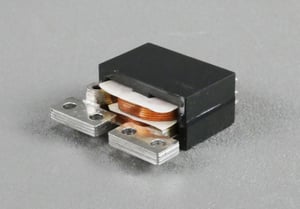Since today's vehicles feature more electronics than ever, demand for electrical components like inductors is increasing. Inductors are essential to the reliable performance of various automotive systems, including braking systems, lighting, engine control, and navigation displays. With high-quality inductors, the transportation and EV industry can keep up with the rising number of electronic control units (ECUs) integrated into each car, especially electric vehicles (EVs).
In this blog, we’ll discuss the importance of inductors in the transportation/EV industry, in addition to the factors driving demand for these electrical components.
What Does an Inductor Do in a Vehicle?

Inductors are a vital aspect of vehicle electrical systems, ensuring that each system performs reliably. In automobiles, power inductors filter out electrical noise and smooth power supply output. They are also used to regulate the voltage in a vehicle's electrical circuits, stabilizing output even when the input voltage or electrical load changes.
Understanding inductors requires some knowledge of the many vehicle systems they're used in. The most common applications for inductors in cars include:
- Engine control units: Inductors filter out electrical noise and interference, safeguarding the accuracy and responsiveness of ECU sensors.
- Infotainment systems: Inductors are incorporated into the power supply circuit to smooth the flow of current to the vehicle’s speakers, display, and other components.
- Lighting systems: When incorporated into the lighting system power supply, inductors improve the light's brightness and stability.
- EV charging systems: Used in the charging circuit, inductors smooth the current flow from the alternator to the battery, preventing voltage spikes and battery damage.
- Regenerative braking systems: Inductors support regenerative braking in bidirectional DC-DC converters (BDC).
- Controller area network (CAN) bus: CAN bus standards ensure efficient communication between ECUs.
Inductors for EVs
Each year, the popularity of electric vehicles grows. From 2022 to 2023, EV sales in the United States increased by 60%. As these vehicles become more prominent, larger quantities of inductors are needed, due to the central role they play in DC-DC converter performance.
The Electric Revolution
Protecting the environment and achieving carbon neutrality are increasingly important goals on a global scale. For the transportation industry, electric vehicles have emerged as a popular solution to these sustainability challenges. Today, numerous major car manufacturers have announced their entry into the EV market, offering vehicles either partially or entirely powered by batteries.
At the same time, the automotive industry is experiencing remarkable technological innovations, including the development of advanced driver assistance systems (ADAS) and autonomous driving technology. Virtually all new vehicles incorporate multiple cameras and sensors to detect information on the surrounding environment. These new tools require more electronic control units (ECUs) than ever before. In fact, it's not uncommon for the newest cars to require more than 100 ECUs, each one related to a different function.
Between applications related to the powertrain, safety systems, and information processing equipment, there is an extensive number of electronically controlled vehicle functions. Inductors must be incorporated into all of these functions to guarantee their reliability and performance.
The Role of Inductors
Power inductors are an essential aspect of DC-DC converters, which are found in all ECUs to adjust the battery's voltage to optimal levels. The role of an inductor is to pass the direct current (DC) freely while creating resistance against alternating current (AC). When coupled with high-speed switching integrated circuits (ICs), inductors enable DC-DC converters to change voltages to the necessary levels.
Power inductors are classified into multiple types, based on their construction. These include:
- Wire wound
- Planar
- Multilayer
- Thin-film
Triad specializes in wire wound and planar inductors that are able to carry large currents. They are commonly referred to as high-current inductors and are often paired with soft magnetic metal or ferrite cores. Multilayer and thin-film inductors are smaller and thinner, handling smaller currents. However, new designs are increasingly able to handle larger currents. Since there are so many ECUs installed in vehicles, more DC-DC converters and inductors are required to meet this demand.
Contact Triad Magnetics for Inductors and Custom Magnetics
With new technologies developing every day, the transportation industry requires inductor providers that can adapt to the challenges of rapid growth. With more than 80 years in the magnetics industry, Triad’s experience adapting to the changing needs of new applications is especially valuable in this fast-growing EV market.
We offer an extensive variety of products for the transportation and EV market, including many standard inductor products that can be adapted to meet new application-specific requirements. To learn more, contact our team or request a quote today.






